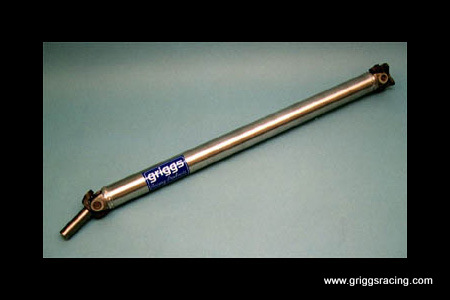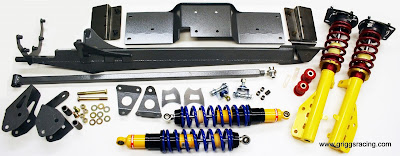We have gone to great lengths to develop Mustang chassis components that meet or exceed the output of modified power plants. In the following post we will outline those components and give you a blueprint for turning your Mustang into a world class sports car.
The Mustang’s chassis was designed in the mid-1970’s, during an oil crisis, to be an inexpensive sedan or station wagon (Fairmont/Zephyr) and not a sports car. It had to be light, cheap and easy to build. The unibody chassis, suspended by McPherson struts (state-of-the-art at the time) and a solid axle, did a pretty good job as a family truckster (cheap!) When the oil crunch eased and Ford stated to think about sports cars again, the only platform they had was the Fox. The new body style Mustang, born in 1979, was built out of revised station wagon parts. The Mustang was soldiered on, to the present day, with the same simple underpinnings.
With the notable exception of dangerously unpredictable handling at the limit (fish-tailing), the current chassis works fairly well. After continual tweaking by Ford, the Mustang feels pretty racy to the average driver. But you wouldn't be reading this if you were the average driver. You may have discovered that Mustang cannot be driven near the limit. If you follow the steps laid out in this catalog, you can plan on owning a car that will pull over 1.0 G on a skid pad and outrun ZR-1s or Vipers in the Slalom without giving you white knuckles. By focusing on geometry and load management, we have developed a blueprint for building the perfect Mustang.
If you think this sounds an awful lot like Math and Physics, bear with us. Making a car perform well is an exercise in managing physical forces. The better you understand these forces, the easier it will be to build your pony-car without wasted time and money. Throughout this catalog, you'll see constant references to geometry and physics and information about roll centers, camber curves, anti-dive and anti-squat. Detailed explanations of all these terms are beyond the scope of this catalog, but where necessary, we have included engineering drawings to help illustrate why our changes are so effective. If you have more detailed questions about geometry changes for your application, please contact us. Our knowledgeable staff is always willing to explain the finer points to a valued customer. To save you the phone call for simpler stuff, we have answered some of the most common questions here.
What should I do first?
If you haven’t made any of the popular modifications to the suspension of your car you are actually ahead of the game. Lots of our competitors sell a set of shocks and stiff springs and sends a guy down the road, even though this can actually hurt performance. The first thing you should really do is to decide what your priorities are for the car: handling, drag strip launches or spirited street driving. Then, before you buy anything, read and understand the technical info in this blog. We have provided a lot of detail because if you understand the flaws of the stock Mustang, you'll probably wind up a customer. If you are careful about defining your goals, you can be sure that your project goes smoothly without wasted dollars on components that require replacement later on. If you can afford to build your entire chassis in one step, you should. You will save money on labor and have the best handling Mustang possible.
Your stuff sounds pretty racy. I just want my car to work better on the street do I really need all this stuff?
90% of our customers are streetcar owners. Our World Challenge and Drag Race customers are a small minority of our total sales. They buy our parts because we engineer our parts to do the best possible job of increasing grip within the confines of the production body and frame.

Since we are so focused on fixing geometry, our cars can be run with soft springs, shocks and sway bars for better performance on rough surfaces with more comfort.
How does the GR-40 Kit affect ride quality? One of my friends already bought springs and shocks and his car rides like a tractor.
Believe it or not, GR-40 cars ride about like a production Mustang. Our focus on high quality shocks, geometric perfection and suspension travel help us deliver ride-quality as good as stock. Our suspensions do, however, reduce the amount of insulation and compliance in the car, to improve its responsiveness. Your car will be a bit noisier over broken pavement or really bumpy surfaces, but in the words of Muscle Mustangs Technical Editor, John Hunkins, (who drove one of our cars from Texas to New Jersey during an east coast tropical storm), “The Griggs Racing approach is to restructure the basic geometry of the suspension from the ground up. By doing so ride harshness, jounce and dartiness at speed are practically eliminated....the GR-40 Mustang feels essentially stock in its ride quality....Other suspension systems have had us begging for mercy but the GR-40 provided a compliant comfortable ride.” (MM&FF, February 1996) We couldn't have said it better.
What about exhaust clearance? How do you guys get all that stuff to fit?
Exhaust clearance actually depends a lot on the car. Ford has very broad production tolerances for things like exhaust hangers and crossover tube location so some cars are easy to fit even with big tailpipes, other cars cause some problems. The problems, however, are really quite simple to resolve and each of our installers has the capacity to make the necessary changes.
I have heard TorqueArms create vibrations. Is this really a problem? If so, can you guys fix it?
TorqueArms do not create vibrations, but they may transmit existing vibrations. 98% of the vibration problem we encounter are the result of poor balance factors within with the original drive shaft. The installation of a high quality lightweight unit (which we offer) will usually sort things out.

The remaining problems are generally the result of a well-meaning installer trying to shim the TorqueArm to create a high-performance pinion angle. There is no such thing! The TorqueArm installation sets the pinion angle, and prevents it from changing under load. If the TorqueArm is installed, as delivered without modification, a car in good condition should not vibrate. However, variations between individual cars may require adjustment to driveline angles–which is a simple procedure.
My street car is supercharged, develops 500 ft./lbs. of torque and traction is terrible. Will the TorqueArm really fix it?
If anybody tells you they can prevent a street tire from spinning on a car with that kind of power, look elsewhere for the truth. It just isn't possible. We can give you the best possible improvement in forward bite that does not compromise the street ability of the car. Mark Ray Motorsport of Charlotte, NC, has a street strip car, which makes 495 ft./lbs. from its Vortech-boosted engine, has run 1.53 60 ft. times on its 8 inch slicks. This kind of time is typical from cars with larger 10 inch slicks!
Moreover, the car launches and runs perfectly straight and is totally consistent. Our testing with radial street tires show consistent reductions of .2 to .3 seconds over any other rear suspension system.
You'll still have some wheel spin, but your car will be predictable and easy to drive.
I have heard all about the GR-40 system. I think I understand it but I have heard you have to do the whole system at once if you want to avoid understeer problems. I can’t afford to spend that kind of money in one chunk. Can the system be done in stages?
Modifications can be done one at a time or in stages. Please call us if you wish to discuss a customized kit. Each additional stage will increase your car’s performance even more than the last, and the total combination gives an unbelievable level of grip and balance.

Call for details on our three-stage method. Either way, with a little planning you can get exactly what you want, save money and keep your car fun to drive at every step of the way.